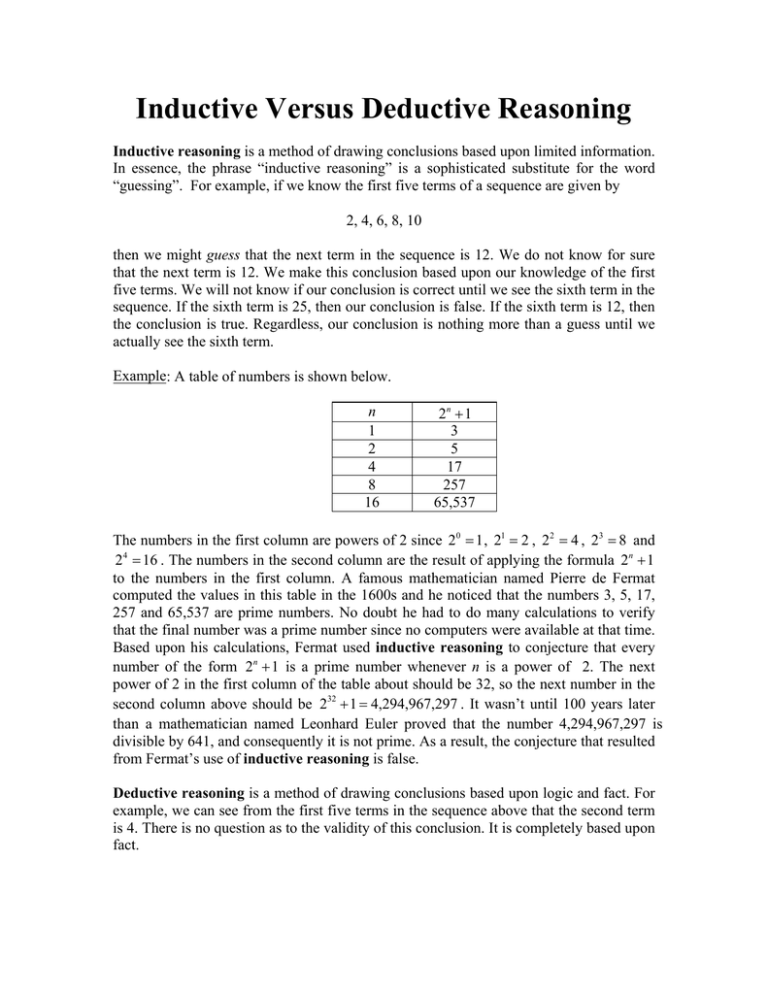Inductive Versus Deductive Reasoning
advertisement

Inductive Versus Deductive Reasoning
Inductive reasoning is a method of drawing conclusions based upon limited information.
In essence, the phrase “inductive reasoning” is a sophisticated substitute for the word
“guessing”. For example, if we know the first five terms of a sequence are given by
2, 4, 6, 8, 10
then we might guess that the next term in the sequence is 12. We do not know for sure
that the next term is 12. We make this conclusion based upon our knowledge of the first
five terms. We will not know if our conclusion is correct until we see the sixth term in the
sequence. If the sixth term is 25, then our conclusion is false. If the sixth term is 12, then
the conclusion is true. Regardless, our conclusion is nothing more than a guess until we
actually see the sixth term.
Example: A table of numbers is shown below.
n
1
2
4
8
16
2n + 1
3
5
17
257
65,537
The numbers in the first column are powers of 2 since 20 = 1 , 21 = 2 , 22 = 4 , 23 = 8 and
24 = 16 . The numbers in the second column are the result of applying the formula 2n + 1
to the numbers in the first column. A famous mathematician named Pierre de Fermat
computed the values in this table in the 1600s and he noticed that the numbers 3, 5, 17,
257 and 65,537 are prime numbers. No doubt he had to do many calculations to verify
that the final number was a prime number since no computers were available at that time.
Based upon his calculations, Fermat used inductive reasoning to conjecture that every
number of the form 2n + 1 is a prime number whenever n is a power of 2. The next
power of 2 in the first column of the table about should be 32, so the next number in the
second column above should be 232 + 1 = 4,294,967,297 . It wasn’t until 100 years later
than a mathematician named Leonhard Euler proved that the number 4,294,967,297 is
divisible by 641, and consequently it is not prime. As a result, the conjecture that resulted
from Fermat’s use of inductive reasoning is false.
Deductive reasoning is a method of drawing conclusions based upon logic and fact. For
example, we can see from the first five terms in the sequence above that the second term
is 4. There is no question as to the validity of this conclusion. It is completely based upon
fact.
Although inductive reasoning can sometimes lead to false conclusions, it can often be a
useful first step in the process of applying deductive reasoning to determine whether a
conclusion is true. We illustrate this with a simple example below.
Example: Pretend for the moment that you are a grade school child. You know the
difference between even and odd numbers, and you know how to multiply numbers. One
of the activities that your teacher has given you involves multiplying natural numbers,
and you notice that every time you multiply an even natural number with another natural
number you get an even natural number. Based upon your observations, you use
inductive reasoning to conclude that the product of an even natural number with a
natural number is always an even natural number. Your conclusion is a guess, but it
might lead you (or someone else) to use deductive reasoning to prove the assertion. We
can do this by giving a precise statement of the assertion and then supplying a proof
based upon logic and facts. To this end, we let ` be the set of natural numbers, and we
let E be the set of even natural numbers. That is,
` = {1, 2,3,...} and E = {2n n ∈ `}
Theorem: If k , m ∈ ` and k is an even number, then the product km is an even natural
number.
Proof: Since k is an even natural number, there is a natural number n so that k = 2n . As a
result, direct substitution and the associative law for multiplication give
km = ( 2n ) m = 2 ( nm )
Since the natural numbers are closed under multiplication, the product nm is a natural
number. So, km = 2 ( nm ) is an even natural number. •
Our use of deductive reasoning removes any doubt as to the validity of the assertion.
There is no need to create a larger multiplication table to check additional values. The
assertion is simply true! However, we might not have ever tried to use deductive
reasoning to prove this assertion without the set of observations that lead to our
inductive reasoning to guess the result. In general, although inductive reasoning can
sometimes lead to false conclusions, it is a good tool for making conjectures which may
be verified using deductive reasoning.






